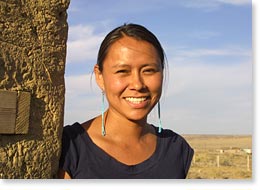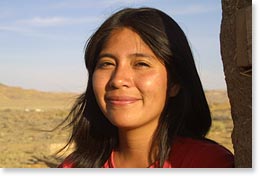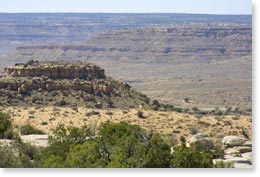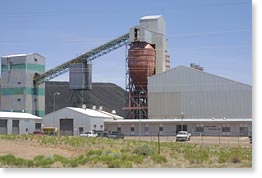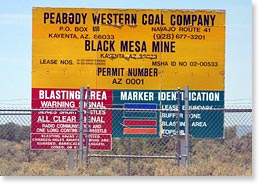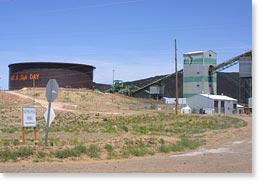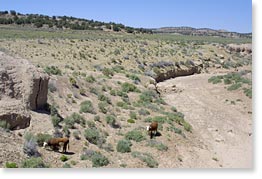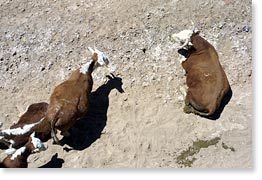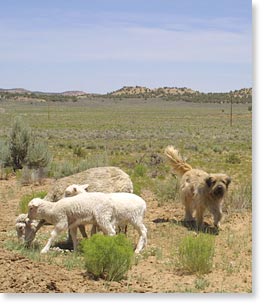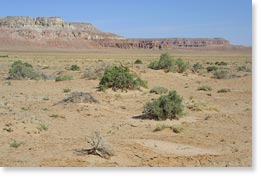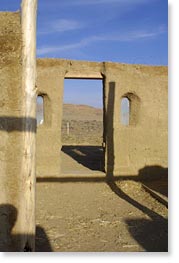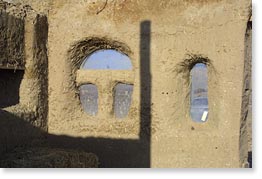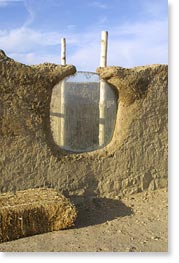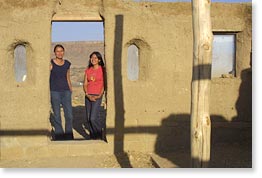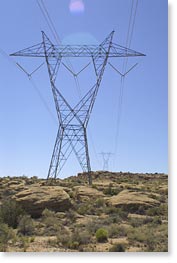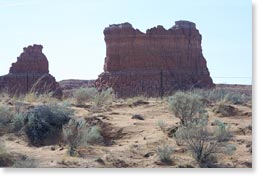|
Interview with Wahleah Johns and Lilian Hill
Black Mesa Water Coalition “We don’t have to be the battery for America” Sustainable Development: It’s Old But It’s New Kykotsmovi, Hopi Nation Arizona
Wahleah Johns: My name is Wahleah Johns and I’m with the Black Mesa Water Coalition. I’m the executive director and I help organize and do public outreach on issues pertaining to water on the Black Mesa, energy related to water, the fossil fuel industry, and trying to promote alternatives: renewable energy and sustainable development. Lilian Hill: My name is Lilian Hill and I’m from Kykotsmovi. I’m Tobacco clan. I’m one of the founders and organizers for the Black Mesa Water Coalition. I’ve been doing a lot of work, since we started, doing community presentations with Wahleah on water issues. Also doing a lot of research into sustainable development and being a practitioner of sustainable development in the form of earthen homes and gardening. In Motion Magazine: When was the Black Mesa Water Coalition founded and why was it founded? Lilian Hill: The organization was founded in October of 2001 and it was founded because there was some youth that came together, Hopi youth, and we decided that something needed to occur in regards to the depletion of our water source by Peabody Energy. They’ve been mining coal on Black Mesa for over 30 years and they’ve been using the water from deep within the earth, from the Navajo Aquifer, to transport coal from Black Mesa to the Mojave Generating Station. Since that time, 30 years ago, up until 2001, we’ve seen a huge impact to the land as far as the vegetation, the amount of water that was available within the traditional springs, within the area where we gather water and where we pray. And then we heard a presentation from a man named Vernon Masayesva. He’s with the Black Mesa Trust. He was giving a lot of information about the amount of water that they (Peabody) have been using and the possible impacts. This really reminded us of those stories that we hear from the elders, as far the prophecies and the things that are going to happen once we start to disrespect the land and the water. We felt that it was time that the young people stood up and took an active role in helping the elders and helping other groups that were involved in this issue. Helping them to get the word out there and helping to try to put a stop to that type of use of water. Regardless if you are Hopi or Navajo In Motion Magazine: How did you go about bringing the youth into the organization? Wahleah Johns: Lilian is coming from the Hopi people; I’m Dine. We are neighboring tribes. The Sierra Club EJ (environmental justice) program was actually wanting to send (to training) young people from these communities that are impacted by the water issue with Peabody. Giving them an opportunity to organize and go through some training on environmental justice and what that means. How to start a campaign. I think that’s when we first came together. For example, I’ve been working in Black Mesa on a number of issues all relating to coal mining and the fossil fuel industry. Also, the relocation that has been happening in Big Mountain, which is not too far from here. It impacts everybody, no matter who you are, if your water source is being threatened, regardless if you are Hopi or Navajo. We have every right to stand up and speak on behalf of our future. That’s how we came together back in 2001. Since then it’s been very educational, a learning experience for all of us who are still young and growing and trying to develop ourselves in a direction that we want to take. Using our cultural values to guide us in this world and in this life. In Motion Magazine: When you say youth -- what age do you mean? Wahleah Johns: With Black Mesa Water Coalition most of the members are university age students, from 18 to 29, 30 years old. Lilian Hill: And then the younger people, the Indigenous Youth Coalition. Wahleah Johns: And these little ones here. We’ve had, at some point, from K through 12th grade in our events or in our gatherings. We’ve always had them involved at some level participating in protecting the water. Wasting and using water that way In Motion Magazine: What is the current situation with Peabody, the mining of the coal, the use of the water to transport the coal? And what is your opinion of the situation? Lilian Hill: I think from when we started in 2001, when we started doing a lot of research and then doing public presentations to the communities, rural communities that don’t have any access to information, as far as the impacts of coal mining, energy, water-use, all of these things, a lot of these communities they didn’t have any idea. With these governments, the Navajo and Hopi tribal governments who are negotiating on behalf of the people, there was a huge effort here on the part of Hopi people from the communities protesting against the use of the water. What people were saying back then, and for a long time since the mine opened up, was that we are not supposed to be mining coal. We are not supposed to be digging in the ground, in the earth. We are not supposed to be wasting and using water that way. That’s what people were saying. So, in 2001, after a huge campaign, mainly by Black Mesa Trust and a lot of people from the community, the Hopi tribal government passed a resolution saying that in 2005 they were going to end the use of the N. (Navajo) Aquifer. Basically, the contract wasn’t going to go beyond 2005 for the use of water by Peabody Coal Company. That’s the resolution that was passed by the Hopi tribal government. Then, working to try and get that same type of resolution passed by the Navajo tribal government has also been a huge struggle and a lot of time has been put forth in that by us and other groups. We managed to get that resolution passed also. To end the pumping of the water to transport their coal What’s been happening is Peabody Coal Company and the Hopi and Navajo tribal governments have been looking for an alternative water source to slurry their coal to the Mojave Generating Station. But there’s several factors that came into this whole issue. The Grand Canyon Trust filed a law suit against the owners of the Mojave Generating station, who is Southern California Edison, a few years back, and what Grand Canyon Trust was arguing was that Southern California Edison were in violation of the Clean Air Act and they were emitting more than they were supposed to be emitting, as far the pollutants. So, there was a consent decree and within the consent decree it stated that the Mojave Generating Station had to install scrubbers and pollution control equipment by 2005 and they had to purchase that by last year, 2003, in order to stay operating as a facility. When this issue came about, as far as the tribes passing resolutions to end the pumping of this water to transport this coal, there was a huge campaign among the tribal governments and the company to try to find an alternative water source and to keep that Mojave Generating Station open a few more years. Now they are looking at another aquifer above the Navajo Aquifer, called the Coconino Aquifer. That water supplies a lot of the water for Winslow and parts of Flagstaff. They are confined water sources. What the company and what these governments are doing is they are still trying to continue their operation using water to transport this coal. It’s one of the only operations of its kind in North America and around the world because of the amount of water it uses. According to this resolution, this year’s going to be the last year the Peabody Coal Company is going to have access to this water. So we are going to hold our governments to that. But there are a lot of negotiations happening and we really don’t know, as far as right now, how these negotiations are working out. As far we know the Mojave Generating Station is closing and Peabody Coal Company is not going to be able to use the water after this year. When that happens it will be a big victory for us but we still have to be cautious about what is going on. Every single day, 3.3 million gallons of water is gone In Motion Magazine: What is your objective? Wahleah Johns: Most definitely for a lot of us doing this work we are beginning to see the number of entities involved: the power generating station, Peabody Coal Company, our Hopi / Navajo governments and mineworkers -- the majority of them are Dine or Hopi. Starting this campaign you start to see these different views. It’s a very difficult thing when you are campaigning to stop the use of our water and try not to offend people, because it’s their work and their job. That’s something that we’ve always had to come up against. But I think for me, ultimately I would like to see this water being stopped. Even today, every single day, 3.3 million gallons of water is gone. That hurts me every day knowing that this slurry line is running every single day and that every single day this water is being abused. I hope they will get off the water as soon as they can because this is definitely something that is in jeopardy. Our lives are at jeopardy. Our way of life is at jeopardy. The majority of the people that live out there on the Rez don’t have running water, nor electricity, but we supply southern California, Nevada, and parts of Arizona with all of their energy needs. You go behind the hill from Peabody and people still have to haul water for their livestock, for their farmlands, for their food, for ceremonies. It’s something that I think that should have been done a long time ago by our leaders, to take a stand. Unfortunately, all this information that we’ve been trying to get out to the communities is barely (out there) right now, 2004. The majority of the people don’t speak English and they can’t read. These past two years we’ve been doing presentations to communities and showing graphs or pictures, trying to make them understand how much water is being used per day by Peabody, by communities, where this water is going. And that whole process, a lot of our people didn’t know just that. At all. Alternatives to the fossil fuel industry I think, hopefully, as community members of Black Mesa we can give alternatives to the fossil fuel industry. It is basically a dying industry and it is unstable, unsustainable. There’s coal deposits there, yes, but we have this connection with these resources where they represent different parts of a body, a human body. Coal, they say, it’s the liver of Mother Earth. And water is the giver of life. We have those connections, traditional stories. As young people we try to relate in that way, and say when we go out there, “We need to transition off this coal, off this water and not abuse it because we have to look at our Mother Earth as a living being. We have to take care of her because it’s like in our stories -- that’s why we are here. To take care of the land. Be caretakers, basically.” That’s how I’ve been taught in looking at nature and protecting nature for the future generations. I would like to see, one day, Peabody not be there any more. We are understanding the whole process, the lifecycle of coal, and what we’ve put it through, as far as exploration, extraction, the combustion, to the waste -- there’s a lot of unhealthy contaminants that are released and people get sick from this process. Hopefully we will continue to relay this information to our people. There’s other ways of building an economy that are more healthy and efficient for our people. We don’t have to be the battery for America. Our lands are being used for the energy highway of the U.S.
Part of that involves advocating for a more sustainable community. We look at our communities, back in the days, even like eighty years ago, fifty years ago, and things were a lot different in our communities. We weren’t so reliant on the cash economy. What our objective is, is to try and bring out those teachings and to do positive things through community presentations, through farming, gardening, natural building, environmental education, and traditional knowledge and education. Trying to find an alternative for ourselves, as young people, so that we don’t have to go and be a part of that system, to be a part of those destructive ways that have been set up. One objective that we have is trying to find alternatives for ourselves and our communities and trying not to participate in those things that are destructive to our communities. Not being involved in a type of economy where huge multinational companies and people we don’t even know are exploiting our communities. We don’t want to be a part of that. Our objective is to look to a more healthy lifestyle and healthier ways. Western science separates everything In Motion Magazine: The Peabody Company says that the water that they take is 3,000 feet down and the water the local people use is surface water. Is that a valid point?Lilian Hill: I think that when you look at the arguments that Western science brings up, Western science separates everything. They separate the water, the different aquifers. They even draw lines and say, “There is this aquifer, this one, and that one, and this.” The way that Western science creates their data and information is not based on the type of cultural outlook that we have in our spiritual teachings that tell us and teach us that there are different beings that reside in the earth. We have our own science and our own belief and understanding of the way that nature works, and the way that the water works underneath the ground. One teaching that we believe is that the water underneath the ground in this place where we live here is a very special place for the Hopi, and also for the Dine people. Within our stories, as Hopi people, we travel to this place where we are now. Our clan stories tell us that we traveled from thousands of miles in some cases, from all different places, to be here. This is the place where we are supposed to be. This is the spiritual center of the world. Here. We are caretakers of this land. So, with the water in the earth, there’s special prayers that are made in ceremonies every year to ensure that that water will continue flowing and it’ll continue to be in balance in that way. What the Hopi believe is that when you plant, we do a lot of planting, we have that belief in the earth that it will take care of us. That deep connection to the earth When we plant that seed, we believe that those seeds and those roots pull up that moisture. They pull it up to the surface and when the green starts to grow, what it does it pulls the moisture from the sky down to recharge everything in the earth, in the ground. There is something natural inside the earth that allows water to flow. We believe that there’s different beings that reside in the earth that take care of that water and care for that. And we insure that continuation through prayers and through offerings. By living that way for thousands and thousands of years, here, and then seeing over the past thirty years that this system isn’t working like it’s been working for thousands of years … ; seeing a lot of these springs just drying up after a long time of flowing; seeing the earth just drying up … A lot of people have that deep connection to the earth through planting, through utilizing different waters from the ground. There are a lot of stories that the older people have of there being a lot of water in the ground. And all of a sudden there’s nothing there and Western science tells us that it can’t possibly be this company that’s pumping millions of gallons of water per day from an area where we don’t get much rainfall. We don’t have that rainfall. And then telling us, the people who live on the earth, that there’s nothing wrong. “There’s nothing wrong with that.” That to me is just ridiculous. Serious, serious problems with the water And there’s been studies. The Natural Resources Defense Council has done a study of the water and the hydrology and geology of this land and they have found serious, serious problems with the water, within science. We’ve also found through research that the different studies that the governmental agencies do, such as the USGS (U.S. Geological Survey) who do monitoring of these wells and areas, and the different criteria that they go by are really outdated. What we believe is that even their data, as far as collecting data and creating publications about the hydrology and geology of this area, is so outdated it cannot deal with what is happening in the ground. Their evaluation and their methods of evaluating are outdated. I don’t think that these reports saying that there’s nothing wrong with the water, I don’t think that they are taking into consideration everything that they need to consider. In Motion Magazine: From 1918 to the 1950s, there was uranium mining in this area. Do you want to talk about that? Have you had ties with the uranium mineworkers? Are there any links? (See “Navajo Uranium Miners Fight for Compensation” by Timothy Benally, Sr.) Wahleah Johns: Oh yes, there’s links all over. Unfortunately, a lot of people were impacted. Workers weren’t properly given equipment to protect themselves so that’s something that has carried through to their children. Then, there’s a lot of families that used the rocks nearby the uranium -- that have been contaminated -- to build their homes. You hear many stories like that. That’s a larger issue here in the Four Corners region, the Colorado Plateau, where the lands and the people have been deeply impacted. I was just at a meeting three weeks ago on radiation exposure and it’s very sad. To this day, a lot of people have not got compensated. To even get compensated, or be recognized, the criteria that they need … To give compensation to a family they need the employer’s word. This is back in the ’50s and a lot of our people back then didn’t have English names. They had traditional names and a lot of them can’t go back and ask their employer, “Show proof that I worked here.” They have to show proof of so many things: that they worked here, that they lived here, that they lived near a downwind area. Those complaints still are here. They haven’t been dealt with. Uranium surrounds us on the eastern side of Navajo, northern side, Utah, New Mexico, all the way south. It’s all around. We work with organizations that work on the uranium mining. A sustainable family and community In Motion Magazine: So, part of what you are doing is not only pointing out what is not working but also you’re trying to build -- well, not build, it’s already here -- popularize sustainable life. And part of that is your house. Do you want to talk about what is going on with that? Lilian Hill: I think with creating a sustainable family and community, it was here, like you said already, and a lot of us forgot about that or went away from that. What we are praying for is to go back to that. To bring the teachings back. To live by those teachings and to try to do things right. Treat each other well. One of the things that I saw, within my own community, was that the type of development that is occurring is, to me, Western development. It’s not the way that we’ve been building as Hopi people, as traditional people. What we are seeing is a lot of these trailers popping up, a lot of eyesores within the community. And one thing that I’ve learned to value over time is the traditional techniques that we’ve been using for a long time to build our homes. The type of knowledge that we have as far as building a house and gathering materials, that whole process of creating a place where a family lives -- there’s a lot of teachings to that process and a lot of people aren’t going by that. One of my interests has been looking into ways to build a home from materials that are locally available. Utilizing a lot of different techniques. Passive solar design. Becoming more in tune with the land and where you are, the different areas, the solstices, the different times of the year. All of those things in building a home.
So, after doing research, and training, and talking to my family and the community, we decided to start building a house for me and my family. Trying to re-learn and utilize that ancient knowledge that we have and to be innovative in doing that. And to teach the little ones, the children, how to go about doing those things for themselves. Being proactive and determined in that way. That’s how we started building the house. It’s been a real learning process and we’ve learned a lot. And the kids have learned. And the community is interested in it. To me, it’s something that I feel I can contribute and something that I want to learn. Something that I want my family and my children to learn. From starting to build the home, up to today, there’s been a huge interest in people wanting to learn how to do this type of building. We’ve had a lot of people here helping with the house. Cob -- sand, clay, straw, and water What the house is built from, it’s built from the natural sandstone that comes from the rock quarry about half a mile away from here. That’s the foundation -- from rocks quarried from nearby. The sand comes from right outside. And the clay that we use comes from probably about 50 yards away in the village. The straw comes from nearby in Flagstaff. Everything comes from here that we are using for the house. The technique that we are using for the walls is a material called cob which is a mixture of sand, clay, straw and water and we mix it in a proportion so that it all binds together -- similar to bread dough or pottery clay. It’s a house that you sculpt together and use your entire body. You use your entire body. There’s no machinery involved in it. The house is handmade, made with the hands and the feet of the community, and the family, and visitors who have come. There’s a different teaching to every element within the house. From before digging in the earth, that prayer, up until you start building. We are trying to use materials that are from this area. Materials that we know where they came from -- the beams, and the roof, the wood. Really not wanting to support industries that practice destructive practices like deforestation. Being committed to that type of way because we deal with mining here and we know those impacts of mining, whether it be coal mining, or like you said uranium mining. We have seen those impacts in the health of our people. Trying to be creative and do those things. For me, that’s my contribution to the world – my little contribution. And we are going to see how it will grow from here. How many people are interested. How we can help inspire people to build their own homes, to plant a garden, do those things for themselves rather than relying on the government or other places like that. In Motion Magazine: Are there other cob houses in the village? Lilian Hill: I don’t think so. I think there are a few cob houses in the state. In Motion Magazine: And yet it’s a traditional Hopi method? Lilian Hill: The way that we are using this material is -- how can I explain? Here at Hopi, the traditional houses were built from sandstone and earth. But with this house it’s a little bit different from the way that they were built back in the days. It’s a method that I am using and that I have adapted to here, that I have kind of created to build with. But it’s the same idea of using what’s here and using the earth and the sandstone. I think the way that they were thinking back then was a little bit different from how I’m thinking today, with the type of training that I have gone through. But the idea is similar. It’s the same thing, the same idea. And a lot of the elders that come here they get really happy about the way that we are building. They say, “This is the way that we used to build a long time ago. This is how it was done. You mix it with your feet. And everyone came to help and we put the walls up together.” They used little pieces of stone and rock. Instead of that I’m using the earth. It’s a little bit different. In Motion Magazine: What have you done that is new? Lilian Hill: It’s not new; it’s just different. People have known about it for a long time. I studied with a group called the Cob Cottage Company and a man named Ianto Evans and his wife Linda Smiley. They have a school in southern Oregon called the North American School of Natural Building. I went there a year and a half ago and studied with them and took a workshop with them on cob building, the same method that I am using here. I learned how to mix cob, to use it to build with, and built a small place up there in Oregon. That was my inspiration and Ianto Evans was the one who adopted that method here in the United States. He comes from Wales and in Wales they have this technique where they mix it with their feet and they build their houses like that, with the earth when it is wet. It’s different from adobe or any other type of material around earth because you mix it with your feet and you build it when it’s wet so you can sculpt. There’s a lot of things you can do with it. So learning that method up there, I came here and tried it, because the sand is a lot different here and the clay is a little bit different. I came here and tried it and I just wanted to build like that. To try that out. But you can go into the villages anywhere around here and you won’t see a house like this. You won’t see something like that here. I don’t know if it’s new. It’s old but it’s new because there’s nothing like it around here. Wahleah Johns: A lot of hogans, our traditional homes, my home, are made out of clay and you can’t find that kind of clay elsewhere, people tell me. It has it’s own natural adhesive. Mixing that with sand, it bonds. On Navajo, on Dine land you can find homes that are built from earth, more than you’ll find them in Hopi. We build with stone here. But on the Navajo Rez there are a lot of houses that are built from earth. Round houses -- hogans. They build that way too. Community organizing and sustainable development In Motion Magazine: You are talking about sustainable development within the context of grassroots organizing. Do you see a connection between the two? Or is it just a coincidence that they happen at the same time? What have you learned about building democracy? Lilian Hill: We have discussions all the time. Why are we in this situation? We just have had to form ideas and talk about it and it has brought about a sense of community within our group. Wahleah Johns: Community organizing and sustainable development, this issue of dealing with natural resources and our consumption … Our way of life, our traditional way of life, and who we are, our teachings … The one thing that we try to go by and learn by -- given the history of the impact of colonization, the impacts of globalization in our communities -- I think we are just trying to uplift more our traditional values and teachings that define life and how to go about this life. We have all this knowledge already. It’s nothing that is new. We are just trying to utilize these teachings of our stories and how we emerged as people to this day where we are at. How we are going to live for the future, for our children. Trying to build that sustainable future for them. That there’s enough water, that they live in a place that has clean air. We identify with everything that is here in this universe. I don’t know how to describe it but everything is connected. Education and science. Everything that we have learned in this Western education it seems like it’s separated. The way society is governed. But for us everything is all in one. You are going to have to learn more about our people. Our own way of governing ourselves Lilian Hill: If you look at history within the last one hundred years, we come from communities and cultures where we’ve had our own way of governing ourselves. We had our own ideas of what it means to have a government. What it means to be a democracy. All these words that we are using today, in the context that our people have used them, in all those elements, there’s always been an understanding between people -- a spiritual teaching. The different ways that we chose leaders. The different ways that leaders were. For Hopi people there wasn’t just one leader. There wasn’t this group of people who could make decisions for everyone. It wasn’t like that. That’s not our form of democracy. The way that we have in some villages, it’s still a traditional way of government. The way that we have is we have a father, the Kikmongwi of the people, and that person, that being is usually a man, and basically what the Kikmongwi represents is he represents a father. He represents the guider; someone there for guidance. He doesn’t make any decisions for anybody; he’s just there for guidance. He prays for the people. If you need support for any type of guidance you go to that person. And there are a lot of other leaders within our ceremonies and those leaders all perform a different function. But within our teachings and understandings a lot of the teachings, everything, the stories, come a lot from the women. And so the clans, the people come from the women. There’s a lot of teachings for both men and women. And the women were real leaders too. They made a lot of the decisions within the households. Within the household, and the family, and clans. The clan women came together and they made decisions. For planting time. For the care of the season. The harvest. All of those things. When you are looking at a traditional and sustainable community, those are the types of communities that we come from. The imposition of the U.S. government But in the last one hundred years, we have seen the impacts from the imposition of the United States government into our communities by putting in these tribal governments that are modeled and based after the United States government, the constitution, the form of government that they have, and their ideas of democracy. Our communities and our governments are modeled after that system, which is a system that people don’t trust here. A lot of the traditional people and the people who believe in those ceremonies and those songs, they have no faith, no belief, no trust in these governments.And here at Hopi it’s just really tense. A tense situation because it’s a “democracy”. This government is a democracy because it’s based after the United States government, in that they say, “Oh, you can vote. We vote on everything.” So that’s what makes it a democracy. “You have representatives in this government from your villages and they represent you, and they give you information on the decisions, and they make the decisions for you. That’s how these governments work.” But for a lot of these people in the villages, they don’t have faith or belief in that system so they don’t vote. They don’t participate in that system because they don’t believe in it. But they are impacted by that system because it is a system that is recognized by the U.S. government and it’s a system that has power to make decisions for everybody. In that way, throughout history it’s been a tense situation with the government and with the people themselves in the communities. But the government is made up of the community members, So, to me, it’s a false sense of democracy. When you look at the traditional stories and the way that we believe in our selves as leaders, it doesn’t fall in line with that. My vision and my hope is that we can start to go away from that type of system. To move away from those governments that were set up by the United States government. The Indian Reorganization Act -- and those types of governments that were set up by that act -- I feel like we need to do something else. We need to go back to each village having their own leaders and each village taking care of their own people like it was back in the day. And for the Dine it’s a little bit different too. They have their own ways. There’s been a lot of changes and a lot of impacts due to the U.S. government, the federal government coming in here and imposing things on our people. Complicated for the grassroots voice to be heard In Motion Magazine: Do you feel like you made progress in going that way in the course of this water struggle in the way people became involved and the way people talked to each other? Wahleah Johns: Definitely it’s brought people together to discuss these issues, about water, and land, and health. And also understanding our tribal government, both Hopi and Navajo, Dine. How it could be very complicated for the grassroots voice to be heard and understood. Having this view of water being sacred, a sacred element. Trying to take that word of the people to the tribal government. Our views about this water and why it shouldn’t be used. That was difficult -- for our governments to recognize the wants of our communities. The traditional people, for us, it took a year and a half for the tribal council to recognize the need. We had somebody like Marshall (Johnson) and Nicole (Horseherder), from that interview (Los Angeles Times Magazine, 6/6/2004, “Gathering Clouds” by Sean Patrick Reily, photos by Gail Fisher). They did a lot. They went to so many communities and got resolutions passed to protect the Navajo Aquifer and our water, about the use of it for Peabody activities -- that’s what the resolution said. But to get that passed and recognize that at the tribal council, it took a year and a half because they kept tabling it, table, table. Those are the kind of challenges that we’ve come up against, with our own people, within our own government system -- the needs and wants of the grassroots and the wants of the tribal government as the tribal government negotiates with Peabody Coal Company and all these entities. But we need our voice there so we are constantly trying to push for our voice to be heard. As grassroots we speak for ourselves. That was one difficult thing that we faced. We got to understand and see how the tribal councils work. Forming tribal councils to sign leases The tribal councils they all formed to sign lease agreements, back in the early 1920s, ’30s. That’s when the tribal councils were formed. The Navajo Tribal Council was formed in that way because prospectors, surveyors came out for oil, and gas, and coal and they found large amounts of these reserves here on the reservations so they wanted to start mining but they couldn’t because we didn’t have tribal representation. That’s why they formed a business council first. And out of that they formed the Navajo Nation Council -- to sign lease agreements. This is how corrupt and under-the-table things have been negotiated, without the consent of the grassroots -- of our land. To this day, we are dealing with those lease agreements. Lilian Hill: One of the impacts that we’ve had in starting to talk about these issues is we’ve seen a lot of people from our community becoming more aware of these issues, becoming more comfortable to talk about these issues, organizing themselves. Those types of things we’ve seen most recently and it is a real success and I feel really hopeful when that happens, when people from the community and the young people start to talk about it. They know about what is happening. For an example, like Wahleah said, for Hopi when the tribal council was established and when the government was trying to mine for coal, they required this Hopi tribal government, which was just composed of a few people from Hopi who basically didn’t have the authority to be leaders within our community. When they formed this tribal government, the U.S. government mandated that they have legal representation. And (according to a) report, called “The Report to Kikmongwi,” compiled by the American Indian Law Alliance, a lot of evidence suggested that the lawyer, whose name was John Boyden, who was hired by the Hopi tribal government and approved by the Secretary of Interior, was working for Peabody Coal Company at the same time that he was representing the Hopi tribe in land claims settlements, and in lease agreements and royalty agreements with Peabody Coal Company. This evidence just came out recently. A lot of this information, nobody knew about it until six or seven years ago. That’s how corrupt things were. That’s how corrupt things can be still today. A lot of these issues with John Boyden, him working for Peabody Coal Company and the tribes at the same time, has a huge impact today and nothing was ever done about it. The money that Peabody pays in royalties to Hopi and Navajo governments is based on that type of relationship that John Boyden had with these companies. It was to the best advantage of this company, the Peabody Coal Company. Now people are seeing this evidence and people are using it when they question the government. “What is really happening?” -- and they refer to that. “We don’t want this to happen again.” People have become really cautious. It’s going to take a lot of time for our people, and our families, and communities to become more aware of what is really happening. To focus their energy in positive ways: teaching the children the language and the culture; and gardening; and planting; and helping each other build their homes, and ceremonies. All of those things, those positive things. I think that’s where it’s at, where we have to focus energy. We’ve been doing political work for four years now and it’s a real struggle and it gets you down. You are supposed to be in a democracy and you have to go through all of these committees and channels and your own leaders won’t listen to you. They put you down. They degrade you as a community member who has a say in this democracy. That type of activity is really hard work but I think if there’s more people becoming aware and the families and the children, if everyone is taking an active role in finding solutions and voicing their concerns, I think that will be a real way that we have to go by. Environmental justice, climate justice, social justice In Motion Magazine: You have a big conference coming up. How are you taking the experience here and letting the people outside the area know about it? Wahleah Johns: It’s going to be wonderful. Last summer we had a youth gathering. We hosted it on Black Mesa. We had 200 participants that came from all over. We had a great time for four days sharing knowledge within our communities -- rural communities and urban communities, youth groups. And we are going to see the same thing at this All People’s Power Summit. It’s going to be July 15-18th and our keynote speaker is Winona LaDuke. We have gotten support from a lot of organizations that are contributing their energy to organizing this event -- so it’s not just the Black Mesa Water Coalition. It’s also other organizations that are doing environmental justice, climate justice, social justice work in communities. We’ve made so many connections with other youth from different parts of the world. We are expecting youth from India, and from South Africa, and South America. They are coming here to share their knowledge. Coming together to share knowledge of how to build sustainable communities and healthier communities. There is a lot of power and a lot of young people out there. We are seeing that today and we have faith in the future. It’s really positive where it’s going. Published in In Motion Magazine July 1, 2004 Also see:
|
||||||||||||||||||||||||||||||||||||||||||||||||||||||||||||||||||||||
If you have any thoughts on this or would like to contribute to an ongoing discussion in the  What is New? || Affirmative Action || Art Changes || Autonomy: Chiapas - California || Community Images || Education Rights || E-mail, Opinions and Discussion || En español || Essays from Ireland || Global Eyes || Healthcare || Human Rights/Civil Rights || Piri Thomas || Photo of the Week || QA: Interviews || Region || Rural America || Search || Donate || To be notified of new articles || Survey || In Motion Magazine's Store || In Motion Magazine Staff || In Unity Book of Photos || Links Around The World NPC Productions Copyright © 1995-2018 NPC Productions as a compilation. All Rights Reserved. |


